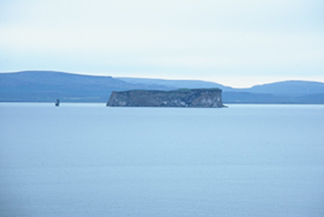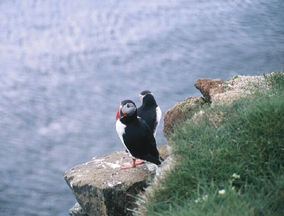|
Travels in Geology May 2007 posted May 18, 2007
Drangey Island: Iceland's bird fortress
 Courtesy of Trausti Tomasson, Destination Iceland |
| Cooled magma formed Drangey Island 700,000 years ago, but ocean waves have since lapped away the volcano's cone until only its inner core of rock remains. Beside it rose what Icelandic legends say were two giant trolls, a man and a woman, turned to stone by after being caught in the sun. Only Kerlingin, or the old woman, remains (left) after Karlinn, the old man collapsed into the sea in the 18th century. |
Drangey Island is all that remains of a 700,000-year-old volcano,
worn away by the ceaseless lapping of the ocean. Nestled in the North Atlantic
fjords, the island is about an hour's boat ride from the northern coast of Iceland.
Local guides lead chartered boat tours to the towering outcrop, which looks
less like an island than an enormous, foreboding fortress guarded by thousands
of seabirds.
Drangey is a sheer cliff face sprouting out of the ocean, rising 168 meters
(about 550 feet) above sea level, or about half the height of New York City's
Chrysler building. Instead of sandy beaches, the North Atlantic waves lap against
a sheer slope of rock. Touring the island takes about two and a half hours,
or five if you also plan a guided climb to the top. The island has just one
access point, which is known as Uppganga ("the way up"). The
guides steer the boat into a tiny cove where a dock is tied haphazardly to the
rocks. The climb up the zigzagging path carved into the cliff face is harrowing
but doable, even for those who wish their visits to the gym were more frequent.
The path is marked with rope and metal rails. The last leg, however, is not
for the faint of heart — it is a 12-meter (40-foot) climb straight up a
steel pipe ladder. Don't look down, as all that lies below is deep blue sea,
more than 50 stories below.
The reward for scaling the cliff is breathtaking. The endless blue sea sprawls
out beneath your perch. The nearly flat island is a long meadow of waving grasses
and wildflowers, spanning 10 football fields. And the ground beneath the grass
is mostly volcanic tuff, a kind of rock made from the ash ejected during the
volcano's eruptions long ago. At the most basic level, volcanoes are composed
of three parts: a reservoir inside the earth that is filled with melted rock
called magma, a chimney through which the magma climbs to reach the surface,
and a cone, formed by the magma that flows out of the chimney and cools into
rock. Drangey Island does not quite follow this model, however. Over the millennia,
the softer lava sides of the cone have been eroded away by the sea, leaving
only the sheer chimney standing, like a giant cork stuffed into the magma chamber
below. The vegetation that now carpets the top of the island is here thanks
to millennia of rocks weathering into soil and bird guano fertilizing it.
The island offers many habitats for birds. Cliff-dwelling, diving seabirds,
such as kittiwakes and guillemots, live dangerously on the steep vertical plunge,
while other species, like terns, make their homes by digging holes in the meadow.
But just because the meadow-dwellers eschew treacherous heights doesn't mean
they are defenseless against intruders. Some of these birds have cultivated
the unpleasant habit of vomiting on the feet of anyone unlucky enough intrude
on their upscale digs. In the spring and summer, Drangey is a prime spot for
bird-watching: Up to 200,000 birds call this island home. In hungry years, Icelanders
survived the long winters by catching the birds, along with their eggs. Locals
still hunt puffins with long nets, and their catch ends up in the finer restaurants
of Reykjavik, the capital of Iceland.
 Courtesy of Trausti Tomasson, Destination Iceland |
| Thousands of seabirds, including puffins, take refuge on Drangey Island. |
Seabirds are not the first tenants on Drangey with antisocial
tendencies. A thousand years ago, this island was allegedly the home of Grettir
the Strong, one of the great outlaw heroes of Icelandic lore. Legend has it
that to evade the consequences of his infamous exploits, Grettir escaped to
Drangey Island and lived there for three years with his brother and a slave.
They killed and ate all the sheep on the island except for a single ram. In
addition to the sheep, Grettir ate the birds and eggs on the island, and drank
from a small hole in a ledge that captures rainwater. This hole, which local
inhabitants call the Well, is the island's only source of freshwater, although
its suitability for drinking is questionable. A small mound on the otherwise
flat meadow top marks where Grettir is said to have once made his home. Legend
tells that in 1031, Grettir's enemies scaled the cliffs near his hut and cut
off his head.
In Icelandic sagas, Grettir swam from his island to mainland Iceland's shores,
as well as other islands in the fjord. You can see the eyebrow-raising path
he is said to have swum, from Drangey to the distant horseshoe-shaped shores
of northern Iceland. On the western coast of Iceland is Hofsós, a small
fishing village of about 250 residents in Skagafjörður (the ð is
pronounced approximately like an amalgam of d and th). To the east are the shores
of Sauðárkrókur, the capital of Skagafjörður. Fishing
trips and tour boats to Drangey can be arranged in Sauðárkrókur.
On the way back to the mainland, you might have the chance to catch your dinner.
The fishing experience here is unrivaled. The waters near Drangey are filled
with cod and halibut. The guides often use fishing poles with three hooks, and
the fish practically beat each other out of the way for the honor of being your
dinner. The locals gut the fish on the boat on the way home and throw the remains
to the gulls, which perform expert airborne maneuvers to float as closely as
they can to the purveyors of scraps.
Many Iceland tours include an outing to Drangey as part of the package. If you
prefer to go on your own, seek out the local guides who take groups on their
boats. You have several options to get to northeastern Iceland. Much of Iceland's
central region is uninhabited, so efficient air and bus transport links northern,
eastern and western coastal towns with Reykjavik, where all international flights
arrive at Iceland's Keflavík International Airport. Most Iceland tours
meet in this city as well. Once there, you can take a smaller and noisier plane
from Reykjavik north to Sauðárkrókur, courtesy of Air Iceland
(these planes depart four times a week and the flight takes about an hour).
From there, you can rent a car and drive out to the shore of Hofsós or
Sauðárkrókur to catch your boat. Another option is a five-hour
bus ride on the coast-hugging Ring Road, which leads you past some startling,
cratered cliffs resembling the surface of the moon. You can also head northeast
out of Reykjavik on this road, across the desolate, uninhabited Möðrudalsöræfi
highlands to the shores of Skagafjörður. Many routes lead to Drangey
Island. You just have to pick one.
Links:
General tourism information:
Icelandic
Tourist Board
Iceland
on the Web
Iceland
Adventure LLC
Iceland transportation information:
Nordic
Adventure Travel
Accomodations in North Iceland:
travelnet.is
Back to top

 Subscribe
Subscribe


